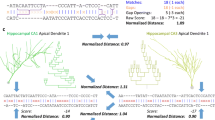Abstract
The constrained tree-edit-distance provides a computationally practical method for comparing morphologies directly without first extracting distributions of other metrics. The application of the constrained tree-edit-distance to hippocampal dendrites by Heumann and Wittum is reviewed and considered in the context of other applications and potential future uses. The method has been used on neuromuscular projection axons for comparisons of topology as well as on trees for comparing plant architectures with particular parameter sets that may inform future efforts in comparing dendritic morphologies. While clearly practical on a small scale, testing and extrapolation of run-times raise questions as to the practicality of the constrained tree-edit-distance for large-scale data mining projects. However, other more efficient algorithms may make use of it as a gold standard for direct morphological comparison.


Similar content being viewed by others
References
Cannon, R. C., Wheal, H. V., & Turner, D. A. (1999). Dendrites of classes of hippocampal neurons differ in structural complexity and branching patterns. Journal of Comparative Neurology, 413, 619–633.
Ferraro, P., & Godin, C. (2000). A distance measure between plant architectures. Annals of Forest Science, 57, 445–461.
Halavi, M., Polavaram, S., Donohue, D., Hamilton, G., Hoyt, J., Smith, K., et al. (2008). Neuromorpho.org implementation of digital neuroscience: dense coverage and integration with the NIF. Neuroinformatics, 6, 241–252.
Heumann, H., & Wittum, G. (2009) The tree-edit-distance, a measure for quantifying neuronal morphology. Neuroinformatics.
Krichmar, J. L., Nasuto, S. J., Scorcioni, R., Washington, S. D., & Ascoli, G. A. (2002). Effects of dendritic morphology on CA3 pyramidal cell electrophysiology: a simulation study. Brain Research, 941, 11–28.
Lu, J., Tapia, J., White, O., & Lichtman, J. (2009). The interscutularis muscle connectome. PLoS Biology, 7, 265–277.
Segura, V., Ouangraoua, A., Ferraro, P., & Costes, E. (2008). Comparison of tree architecture using tree edit distances: application to 2-year-old apple hybrids. Euphytica, 161, 155–164.
Sholl, D. A. (1953). Dendritic organization in the neurons of the visual and motor cortices of the cat. Journal of Anatomy, 87, 387–4061.
Van Pelt, J., Uylings, H., Verwer, R., Pentney, R., & Woldenberg, M. (1992). Tree asymmetry—A sensitive and practical measure for binary topological trees. Bulletin of Mathematical Biology, 54, 759–784.
Vetter, P., Roth, A., & Hausser, M. (2001). Propagation of action potentials in dendrites depends on dendritic morphology. Journal of Neurophysiology, 85, 926–937.
Zhang, K. (1996). A constrained edit distance between unordered labeled trees. Algorithmica, 15, 205–222.
Acknowledgements
We would like to thank Giorgio Ascoli for his valuable discussions as well as Maryam Halavi and Deepak Ropireddy for their useful feedback.
Editorial Note
The authors of the target article (Heumann and Wittum 2009) acknowledge that the commentary is correct and thank its authors. They also add that complexity issues have not been considered in the present paper, since there was no problem to run the code on the specified data. Because the algorithms can be parallelized easily, they do not see serious complexity problems in using the methods on larger datasets. Complexity issues will be the topic of a forthcoming paper.
Information Sharing Statement
The source code for the algorithm, compilation and usage instructions, and sample reconstruction files (.hoc) were provided by the authors through the Neuroinformatics editors. NeuroMorpho.Org data was retrieved through the v.3.2 database with permission and access provided by the database curator.
Author information
Authors and Affiliations
Corresponding author
Rights and permissions
About this article
Cite this article
Gillette, T.A., Grefenstette, J.J. On Comparing Neuronal Morphologies with the Constrained Tree-edit-distance. Neuroinform 7, 191–194 (2009). https://doi.org/10.1007/s12021-009-9053-2
Received:
Accepted:
Published:
Issue Date:
DOI: https://doi.org/10.1007/s12021-009-9053-2




